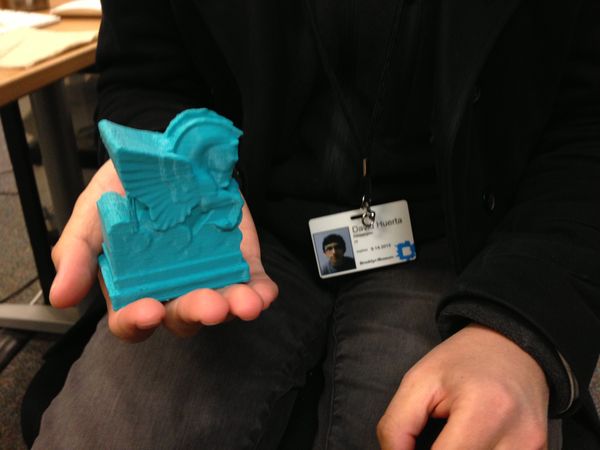3D Printing for Accessibility
In the last year, we’ve seen a lot happening in the museum space with 3D printing. The Smithsonian is working on what looks like a enormous project, the Met has a ongoing series of initiatives that look pretty cool, the San Francisco Asian Art Museum has hosted a “scanathon,” and the Art Institute of Chicago has been actively working in the space—just a handful of current projects going on.
As part of an internal program within the Technology department, we’ve started a series of developer led R&D projects; developers propose what they want to experiment with and we set aside time in our busy work week to foster that creativity. In our first round of experiments David Huerta wanted to work with 3D printing; he’s incredibly passionate about this and has been following the 3D printing projects in the industry and beyond.

Irwin S. Chanin (American, 1891-1988). Double Pegasus from the Coney Island High Pressure Pumping Station, 2301 Neptune Avenue, Brooklyn, 1936-1937. Limestone, granite, 48 x 24 x 48 in. (121.9 x 61.0 x 121.9 cm). Brooklyn Museum, Lent by The City of New York, L2003.7.2.
I’ll say I needed some convincing; even in asking the team to experiment, my own thoughts tend to take me toward practical applications and, while 3D printing is whiz bang cool and a lot of people had ideas for applications, we just were not seeing much materialize just yet. But, you never know where a project can lead you, so David started his project by working with the Double Pegasus—an object from Coney Island which greets visitors in our sculpture garden.

David Huerta with his 3D print of the Double Pegasus.
When he showed up with his 3D print, we were pretty excited and that little physical simulacrum got me thinking about practical applications and how something like this might be used to help our educators with their own goals in helping visitors who are blind or partially sighted. After speaking with Rachel Ropeik in our Education department, she immediately saw the possibilities and wanted to experiment; David and Rachel are now working on a cross-departmental project to bring 3D printed objects into our series of Sensory Tours.
We consider this a fast, iterative project that aims to get the output right into our visitors hands as we report back on our findings. We’ve had plenty of bumps in the road—just finding an object that was appropriate for their tour combined with our own ability to capture it was challenging. In the coming week or two, David will blog a lot more on the technical ins and outs of the project and Rachel will be reporting about education goals and visitor reaction. The Double Pegasus is just the start.

Shelley Bernstein is the former Vice Director of Digital Engagement & Technology at the Brooklyn Museum where she spearheaded digital projects with public participation at their center. In the most recent example—ASK Brooklyn Museum—visitors ask questions using their mobile devices and experts answer in real time. She organized three award-winning projects—Click! A Crowd-Curated Exhibition, Split Second: Indian Paintings, GO: a community-curated open studio project—which enabled the public to participate in the exhibition process.
Shelley was named one of the 40 Under 40 in Crain's New York Business and her work on the Museum's digital strategy has been featured in the New York Times.
In 2016, Shelley joined the staff at the Barnes Foundation as the Deputy Director of Digital Initiatives and Chief Experience Officer.
